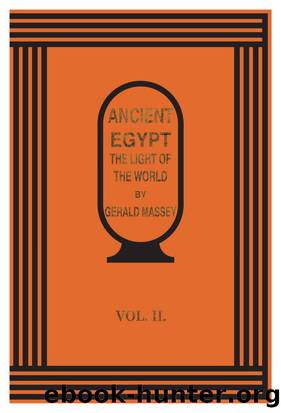Ancient Egypt: The Light of the World (Volume 2) by Massey Gerald (1828-1907)

Author:Massey, Gerald (1828-1907)
Language: eng
Format: epub
Tags: Comparative Mythology;Ancient Egypt;Jesus Christ
Bambino; Horus, of the triangle (reversed) \ "y (Lapidarian
Gallery of the Vatican, Lundy, p. 92). Horus in his resurrection betwixt the two trees; Horus attended by the two divine sisters, or two women; Horus as the lion of the double force; Horus as Serapis; these and others were reproduced as Egypto-gnostic by gnostic artists in illustration of Egypto-gnostic tenets, doctrines, and dogmas. The Catacombs of Rome are crowded with the Egypto-gnostic types which had served to Roman, Persian, Greek, and Jew as evidence for the non-historic origins of Christianity. To Marcion of Pontus, for
example, the epicene Serapis would represent the soul of both sexes which was the non-historical Egypto-gnostic Christ. Horus of the inundation brings the fish and grapes for the Uaka festival ("Called Christ as a Fisherman," Lundy, fig. 54). Horus still issues from the mummy as the young sun-god with the head of Ra, the same as in the Ritual. The soul of Ra still issues from the sepulchre as the phoenix = bennu; and Osiris comes forth at the call of Horus from the tomb. Amsu still rises from betwixt the trees of Nut and Hathor as the good shepherd with the lamb upon his shoulder, wearing the cloak of royalty, and carrying the panpipes in his hand as a figure of the All-one, that is, as Horus of the resurrection. Double Horus, as the child of the virgin and the son of God the Father, is portrayed in both his characters as the heir of Seb, god of earth, and the heir of Ra, the father in heaven. As the heir of Seb he is seated on a throne that is supported on the head of an aged man, who represents the god of earth ("Sarcophagus of Junius Bassus," Lundy, fig. 41). As the heir of Ra he is enthroned in heaven, or on a figure of heaven (Nut), as Horus divinized (Lundy, fig. 42; Didron, figs. 18 and 66). The ox and the ass which appear in the Roman Catacombs with the worshippers of the new-born infant are witnesses for Iusa, and not for an historical Jesus. Iusa in Egypt had been represented by both the ass and the ox, or the short-horned bullock, in the cult of Atum-Ra at On. In a sculptured sarcophagus of the fourth century, the three Magi are offering gifts to the divine infant, or mummy-child. These, according to their caps, are Zoroastrians. They are worshippers, however, of the risen Christ. Only the risen one in this case is Mithra, son of the sun, and not the Jewish Jesus. The story of Jesus riding on two asses, or on an ass and the foal of an ass, in the triumphal procession to Jerusalem also shows that he was one with Iusa, the Egyptian Jesus. It has been suggested that the Gospel narrative was derived from the Greek tradition of Dionysius riding on two asses. But it is of incomparably greater likelihood that it was derived from the Hebrew prophecy being converted into an historical event.
Download
This site does not store any files on its server. We only index and link to content provided by other sites. Please contact the content providers to delete copyright contents if any and email us, we'll remove relevant links or contents immediately.
| Ancient & Controversial Knowledge | Ghosts & Hauntings |
| Hermetism & Rosicrucianism | Magic Studies |
| Occultism | Parapsychology |
| Supernatural | UFOs |
| Unexplained Mysteries |
Animal Frequency by Melissa Alvarez(3755)
Sigil Witchery by Laura Tempest Zakroff(3651)
Real Magic by Dean Radin PhD(3568)
Fingerprints of the Gods by Graham Hancock(3212)
The Rosicrucians by Christopher McIntosh(3049)
Aleister Crowley: The Biography by Tobias Churton(3019)
Journeys Out of the Body by Robert Monroe(2984)
Alchemy and Alchemists by C. J. S. Thompson(2911)
Mysteries by Colin Wilson(2885)
Hitler's Monsters by Eric Kurlander(2731)
John Dee and the Empire of Angels by Jason Louv(2710)
Wicca: a guide for the solitary practitioner by Scott Cunningham(2704)
Infinite Energy Technologies by Finley Eversole(2492)
The Hatha Yoga Pradipika (Translated) by Svatmarama(2482)
Dark Star Rising by Gary Lachman(2419)
Aliens by Jim Al-Khalili(2382)
The Book of Lies by Aleister Crowley(2382)
To Light a Sacred Flame by Silver RavenWolf(2353)
Hitler's Flying Saucers: A Guide to German Flying Discs of the Second World War by Stevens Henry(2293)
